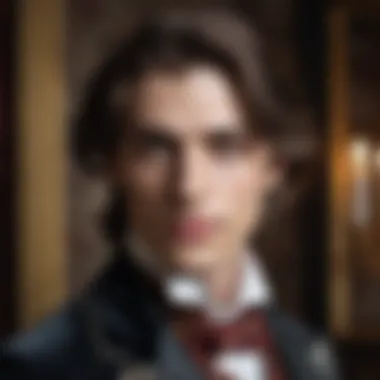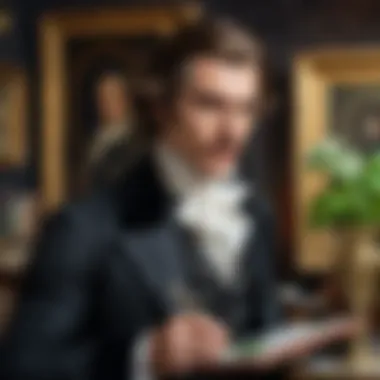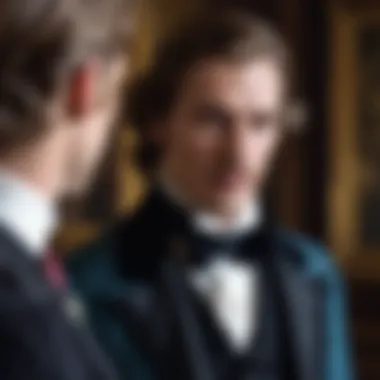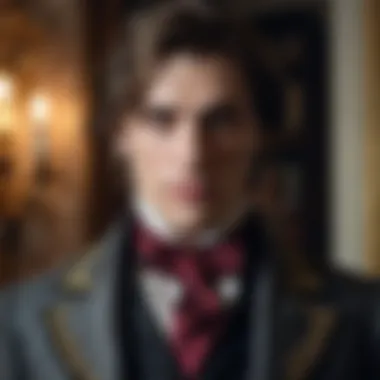Exploring the Characters in The Picture of Dorian Gray


Intro
Oscar Wilde's The Picture of Dorian Gray stands as a landmark in literature, showcasing various characters who represent the inextricable ties between beauty, morality, and the intricate fabric of human nature. Through these characters, Wilde crafts a narrative that compels readers to contemplate the often contradictory impulses driving individuals. In this exploration, we will dissect key figures, unveiling their motivations, relationships, and broader implications within this classic work.
Major Literary Genres
The novel straddles various literary genres, primarily incorporating elements of Gothic fiction, social satire, and philosophical discourse. Each genre contributes to a multifaceted view of human experience, allowing Wilde to delve deeply into themes of aesthetics and ethics.
Classification by Genres
- Gothic fiction: The dark undercurrents in Dorian Gray's life and the haunting portrait echo the conventions of a Gothic style. The psychological depth and moral decay present throughout the story signify its alignment with this genre.
- Social satire: Wilde's sharp wit critiques Victorian society. The characters mirror the follies and hypocrisy of their time, making social commentary that rings true even today.
- Philosophical discourse: The text is rich with discussions around self-identity and morality, with characters grappling with the duality of existence. Wilde presents philosophical ideas through dialogue, elevating the narrative beyond mere storytelling.
Characteristics of Each Genre
Each genre enhances the story in unique ways:
- Gothic elements emphasize the dark consequences of Dorian's choices, helping to manifest the themes of regret and soul corruption.
- Social satire critiques societal expectations and the obsession with superficial beauty, illustrating how such obsession can warp character and morality.
- Philosophical discussions challenge readers to reflect on the nature of happiness, the pursuit of pleasures, and the ethical costs involved in self-indulgence.
Character Analysis
The relevance of the characters in The Picture of Dorian Gray is undeniable, as they each contribute to the overarching themes while embodying personal struggles. This section will break down prominent figures in the novel, starting with Dorian Gray himself.
Dorian Gray
Dorian, the protagonist, epitomizes the dangers of hedonism. Initially innocent, his transformation begins when he first gazes upon the portrait painted by Basil Hallward. The portrait serves as a symbolic representation of his soul, reflecting the degradation of his morals as he succumbs to a life of pleasure. His journey embodies the struggle between outward beauty and inner decay, compelling readers to ponder the profound impact of choices on human nature.
Lord Henry Wotton
As a catalyst for Dorian's descent, Lord Henry acts as both mentor and devil, instilling ideas of aestheticism in Dorian. His aphorisms promote a life centered on sensual experiences, often disregarding the potential moral ramifications. Wilde crafts Lord Henry as a charismatic figure, whose allure and profound insights resonate.
"The only way to get rid of temptation is to yield to it."
This quote encapsulates Lord Henry's philosophy and illustrates the debauchery that ultimately anchors Dorian’s fate.
Basil Hallward
Basil serves not only as the artist but also as a figure of moral integrity. His affection for Dorian is genuine, and he views beauty as something sacred. Basils’s conflict arises from his admiration for Dorian’s looks and the realization of the corruption consuming him. This complexity adds depth to the narrative, as Basil ultimately pays the price for his fascination with both art and Dorian.
Sibyl Vane
Sibyl symbolizes the intersection of art and reality. Her talent draws Dorian in, representing a briefly pure love. However, when her art fails to reflect the truth of their relationship, Dorian’s affection dissipates, illustrating how beauty can be fleeting, and often, love may falter when confronted with true depth.
Closure
In dissecting the characters of The Picture of Dorian Gray, we unveil a rich tapestry that explores the implications of beauty, morality, and self-indulgence. The interactions and transformations of these figures prompt both reflection and critique of human nature. Oscar Wilde's masterpiece invites readers into a complex world, challenging preconceived notions while revealing the darker sides of desire and aesthetics.
Prologue to The Picture of Dorian Gray
The exploration of characters in Oscar Wilde's The Picture of Dorian Gray serves as a crucial cornerstone for understanding the overarching themes of the novel. Wilde's characters are more than mere vessels for narrative; they embody complex philosophies and moral dilemmas that challenge the norms of their society. Each character, from the charming Dorian to the manipulative Lord Henry and the devoted Basil, offers a unique perspective on aesthetics, morality, and the human condition. The interactions among these characters reveal the duality of beauty, leading readers to question the very nature of existence and the consequences of one’s desires.
When diving into the characters, we uncover a multilayered tapestry that invites deeper analysis, making it pertinent to explore their motivations and conflicts. Engaging with these figures helps us to not only appreciate Wilde's critique of Victorian society but also to reflect on our own moral compositions. This article will meticulously peel back the layers of each character’s persona, illuminating the distinct roles they play and their reflections on beauty and vice.
Overview of the Novel


The Picture of Dorian Gray tells the story of a young man whose portrait ages while he retains his youthful appearance, signifying the divergence between outward beauty and inner moral decay. In an era obsessed with aesthetics, this narrative reveals the dangers of excessive indulgence in beauty and pleasure without conscience. Wilde paints a vivid picture of the interplay between art and life, compelling readers to ponder how far one's quest for beauty might lead to corruption.
This novel does not just focus on the protagonist, Dorian Gray; it also highlights the dynamics between key characters that shape Dorian’s journey. Through an intricate narrative, the theme of hedonism intertwines with the consequences of choices made by Dorian, shaping the essence of the story.
Contextual Background
Delving into the context surrounding The Picture of Dorian Gray enriches our understanding of its characters and themes. Written during a time when Victorian society held strict moral codes yet was also captivated by artistic experimentation, the novel reflects the simultaneous celebration and vilification of beauty and excess. Wilde himself navigated the complexities of his era, embodying the tensions between public morality and private vice.
In the late 19th century, discussions surrounding aestheticism, where beauty was revered and morality questioned, were gaining momentum. Wilde's work often challenges these societal pressures, showing the impact on individuals like Dorian, who becomes a pawn in the game of societal expectation versus personal desire. The relevance of this context cannot be understated; it not only shapes the characters but also leads to a deeper understanding of Wilde's commentary on the duality of human nature.
"Experience is merely the name men gave to their mistakes." - Oscar Wilde
This quote encapsulates Wilde's perception of the folly inherent in human behavior, making the journey of his characters all the more relatable and poignant.
Dorian Gray: The Protagonist's Journey
Dorian Gray serves as a pivotal character in Oscar Wilde's narrative, embodying the complex interplay of desire, morality, and the search for identity. His journey is not just a tale of personal development; it reflects the broader themes of the novel, particularly those of beauty, corruption, and the consequences of unchecked hedonism. Understanding Dorian's transformation through the lens of physical and psychological change enriches our appreciation of Wilde’s critique of Victorian society. Delving into the duality of Dorian's character unveils the delicate balance between innocence and experience, ultimately shedding light on his tragic demise.
Physical and Psychological Transformation
Dorian Gray's transformation is a remarkable part of his character arc. Initially, he is introduced as a young man of striking beauty, almost angelic in his innocence. This beauty becomes his curse and blessing. As Dorian becomes enthralled by the idea of youth and aesthetic pleasure, represented by Lord Henry's influence, he allows his exterior to become a mere facade for his increasingly corrupt soul. The turning point comes when he wishes for his portrait to bear the marks of age and sin, effectively separating his physical self from his moral decline.
Dorian’s psychological state sharply deteriorates as he delves deeper into a life of indulgence. His actions become increasingly erratic and desperate, reflecting a man grappling with his own conscience while remaining driven by desire. This distinction between his external allure and internal decay is significant:
- Physique: His youthful appearance remains unchanged, showcasing his wish for eternal beauty.
- Psychological Changes: His mind grows darker. He becomes detached from others, turning to substances and vices in search of pleasure, showing how physical beauty cannot mask moral corruption.
Through Dorian’s descent, Wilde probes the question of what it means to be truly human in a society that values superficial qualities over intrinsic worth.
Dorian's Desire for Eternal Youth
The quest for eternal youth is perhaps Dorian Gray's most compelling motivation. Dorian's initial encounter with the portrait—a captivating piece created by Basil Hallward—gives life to this desire. The idea that he can escape the ravages of time and morality becomes an obsession that drives many of his choices. The portrait serves as a constant reminder of his transgressions, but it also represents the allure of a life lived without consequences.
This obsession is not merely about physical appearance; it reflects a deeper yearning to escape the burdens that come with aging and societal expectations. Dorian begins to view youth as the ultimate virtue, subscribing to Lord Henry's hedonistic worldview. His desire leads him down a perilous path where he forsakes love and genuine connection in favor of fleeting pleasures. The implications are profound:
- Result of Indulgence: Dorian's relationships become shallow. He fails to connect meaningfully with Sibyl Vane, ultimately leading to tragedy.
- Consequence of Choices: The pursuit of youth invites moral decay, culminating in a tormented existence where pleasure is a fleeting shadow rather than a source of fulfillment.
Ultimately, Dorian's journey serves as a cautionary tale about the dangers of objectifying beauty and forsaking deeper values. In Wilde's view, the cost of eternal youth is far greater than its superficial allure, resulting in a life filled with emptiness and regret.
Lord Henry Wotton: The Master Manipulator
Lord Henry Wotton emerges as a pivotal figure in Oscar Wilde's novel, serving as a catalyst for Dorian Gray's transformation. Through his charm and sharp witt, he embodies the philosophy of aestheticism, which is a key theme throughout the text. As a character, Lord Henry is not just a friend or mentor to Dorian; he represents the seductive allure of a life focused solely on pleasure and beauty, without regard for consequence. His existence in Dorian's world unveils the dangers of excessive hedonism and the fleeting nature of youth, making the exploration of his character essential to understand Wilde's broader commentary on society's mores.
Philosophy of Aestheticism
The philosophy of aestheticism can be defined as the belief that beauty and aesthetic experiences are of the utmost importance in life. Lord Henry is a fervent advocate for this doctrine, often using his eloquent speech to sway Dorian’s views on life and morality. For instance, when Lord Henry introduces Dorian to the idea that one should live for pleasure, he effectively replaces traditional moralities with a hedonistic pursuit of enjoyment.
This philosophy is articulated in several of Lord Henry’s conversations, where he promotes the idea that one should "be a master of their own fate" and prioritize their own sensations over societal expectations. Such notions resonate deeply with Dorian, who becomes increasingly enamored by the prospect of eternal youth and beauty. Lord Henry’s desire to liberate Dorian from the shackles of societal restraint exemplifies how this philosophy can be both enthralling and dangerous. The consequences of such beliefs spiral into the chaos of Dorian's life, emphasizing the duplicitous nature of aestheticism.
Influence Over Dorian
The dynamic between Lord Henry and Dorian is complex and multifaceted. Lord Henry is not merely an influencer; he represents a dark mirror that reflects Dorian's latent desires. Here's how he manages to exert his influence:
- Eloquent Persuasion: Lord Henry’s captivating rhetoric hooks Dorian, who begins to see the world through his lens—one filled with indulgence and self-gratification.
- Moral Corruption: As their friendship deepens, Lord Henry's lack of moral compass begins to seep into Dorian’s character. Dorian's initial innocence deteriorates under Lord Henry’s watchful eye, burgeoning leading him down a path of debauchery.
- Symbol of Temptation: Lord Henry, with his nonchalant views on morality, symbolizes the temptation to embrace a life free from ethical constraints. Dorian's transformation speaks volumes about the fragility of youth and beauty when exposed to unchecked desires.
In essence, Lord Henry acts as both a guide and a puppet master, manipulating Dorian’s journey into a descent that ultimately leads to his downfall. The duality of Lord Henry's character—as both a mentor and a villain—underscores Wilde's keen exploration of the conflicts inherent in aestheticism and hedonism.


Basil Hallward: The Artist's Obsession
Basil Hallward stands at the heart of Oscar Wilde's narrative, embodying the blend of artistic genius and the perilous chase of beauty. His character plays a fundamental role in delineating the intricate relationship between art, obsession, and morality. As the artist who becomes enthralled by Dorian Gray, Basil exemplifies how beauty can invoke unease, yet simultaneously, offer an escape. Wilde uses Basil to explore the depths of passion that can both inspire and corrupt.
Symbolism of Art and Beauty
Basil Hallward’s portrayal is steeped in the symbolism of art itself. He sees Dorian not merely as a subject but as a real-life embodiment of the ideal aesthetic. To Basil, Dorian’s beauty transcends physical allure—it represents the purity of inspiration and the ephemeral nature of artistic creation. Their connection highlights how art’s allure can sometimes obscure the darker implications of obsession.
- Basil’s Portrait: The portrait of Dorian is significant; it’s not simply a painting—it’s a mirror reflecting Dorian’s soul. As Basil infuses this artwork with love and devotion, the canvas becomes a vessel for Dorian's spirit, capturing his youth and beauty while everything else fades. The portrait serves as a haunting reminder of what Dorian once was, contrasting starkly with his moral decay.
- Art as a Double-Edged Sword: Wilde cleverly illustrates how beauty, celebrated through art, can also be a source of destruction. Basil’s holy reverence for Dorian’s appearance leads him into a treacherous realm, where admiration morphs into obsession. Just as art can elevate humanity, it can also imprison it, turning admiration into lust.
As Dorian ventures deeper into a life of decadence, the portrait’s transformation acts as a forewarning of the moral decline. The more Dorian indulges, the uglier the image of the portrait becomes, emphasizing the stark difference between idealistic beauty and the grotesque reality of a corrupted soul.
Conflict Between Artistic Integrity and Corruption
Basil's struggle represents a profound conflict—the distressing gap between artistic integrity and the lure of corruption. He starts as a devoted artist, whose respect for beauty shines through his work. However, as he grows increasingly intertwined with Dorian’s spiraling descent into hedonism, this integrity is put on trial.
- The Artist’s Dilemma: Basil initially maintains a moral regard for Dorian. His reluctance to expose Dorian to the hedonistic tendencies of Lord Henry signals his awareness of potential corruption. Yet, as the narrative unfolds, the undeniable charm of Dorian pulls him deeper into a transgressive bond. This dilemma paints Basil as a tragic figure torn between his artistry and the haunting pull of passion.
- Consequences of Influence: Basil’s ultimate fate is a poignant reflection on the corrupting influence of unchecked beauty and obsession. His love for Dorian, once pure, turns into a destructive force, demonstrating how art and personal values can clash in insidious ways. The more Basil tries to protect Dorian from the darker aspects of life, the deeper he sinks into chaos, indicating that obsession, in whatever form, brings with it inescapable consequences.
"Art is the most beautiful of all lies. It seeks to capture beauty, while revealing the grim truth behind the façade."
In summary, Basil Hallward's character serves as a critical lens through which we explore the themes of beauty, obsession, and moral ambiguity in Wilde's work. His journey reminds us that the pursuit of beauty can lead to glorious creations, but when intertwined with obsessive love, it can catalyze ruin.
Sibyl Vane: The Tragic Muse
In Oscar Wilde's The Picture of Dorian Gray, Sibyl Vane represents a pivotal point in the narrative, embodying the themes of idealized beauty and the tragic consequences of a shallow existence. Sibyl, a young actress, falls deeply in love with Dorian Gray, which sparks both passion and disaster. The exploration of her character sheds light on the broader commentary Wilde makes regarding love, art, and the haunting impact of societal expectations, making her role essential in understanding the overall arc of the story.
Significance of Theatricality
Sibyl’s world is defined by theatricality; she exists in the realm of performance. Her identity as an actress allows her to transcend her mundane life, bringing an alluring mystique that captures Dorian’s heart. However, her art is not merely a means of self-expression; it is a lens through which Dorian experiences profound emotions. Her ability to become someone else on stage highlights the intricate relationship between appearance and reality, a recurring motif throughout Wilde's narrative.
- The Role of Play Acting: Sibyl's performances are not just exhibitions of talent; they are a reflection of her inner struggles and desires. Each role she embodies serves as a foil to her true self, making the eventual decline of her character all the more tragic.
- Dorian's Idealization: Initially, Dorian is enchanted by her artistic prowess, seeing in Sibyl a beacon of beauty and innocence. He falls in love not just with her but with the idea of what she represents, which is an ideal often marred by the real-life complexities of existence.
"Sibyl Vane offers Dorian a glimpse of the sublime, only for this vision to be shattered by the harshness of reality."
The Impact of Dorian's Love
Sibyl’s relationship with Dorian dramatically alters her life trajectory. At first, their love seems to offer Sibyl a chance for happiness, but as the narrative progresses, Dorian’s shallow affections expose her fragility. His affection prompts her transformation from a confident actress to a despairing woman whose individuality collapses under the weight of his expectations.
- Transformation Through Love: Dorian awakens feelings within Sibyl that she has never experienced. However, his capricious nature turns her love into a curse rather than a blessing. As he grows increasingly self-absorbed, Sibyl loses her sense of self, leading to a tragic demise.
- The Breaking Point: The turning point occurs when Dorian dismisses her acting after she fails to perform convincingly in Romeo and Juliet. For Sibyl, the disconnect between love and art becomes her downfall, resulting in a catastrophic emotional unraveling, ultimately leading her to take her life, which powerfully underscores the consequences of Dorian's hedonism.
Through Sibyl Vane, Wilde illustrates profound themes of love intertwined with tragedy, acting as both victim and muse in Dorian Gray’s tumultuous journey. Her character not only deepens the narrative but raises questions about authenticity, artistry, and the often fragile nature of human connections.
The Role of Minor Characters
In Oscar Wilde's The Picture of Dorian Gray, the minor characters serve as essential cogs in the intricate machinery of the story. Though at first glance they might seem to play a secondary role, their contributions are critical in shaping the narrative and enriching the primary themes. They not only provide context and contrast to the main figures like Dorian Gray, Lord Henry Wotton, and Basil Hallward, but they also reflect societal norms, offering a commentary on the main action and ideological underpinnings of the novel.
One cannot overlook how these characters bring to light Dorian's evolving morality and the consequences of his actions. Here are some notable elements regarding their roles:
- Catalysts for Change: Minor characters can act as triggers that reveal deeper insights into Dorian's psyche. For example, Sibyl Vane's tragic downfall is not merely a personal loss for Dorian but a critical point that forces him to confront the devastating effects of his hedonistic lifestyle.
- Representation of Society: Characters like Agatha and James Vane depict the broader societal implications of Dorian's actions. They embody the voices of morality and consequence often drowned in the noise of beauty and superficiality.
- Moral Echoes: Each minor character adds layers of moral complexity to the story. Through their interactions with Dorian, one can observe the ripple effects of his choices, highlighting the novel's critique of aestheticism and the abandonment of ethical considerations.
The Influence of Lord Henry's Circle
The characters within Lord Henry Wotton's circle play significant roles in shaping Dorian's character and ethical beliefs. Lord Henry himself, with his cynical worldview and flamboyant lifestyle, introduces Dorian to a realm where beauty reigns supreme over decency and responsibility. The minor characters in this circle reinforce the values of hedonism and indulgence that Henry propagates.


- Victor: Though he does not have a prominent role, Victor embodies the sycophantic nature of those who revolve around Lord Henry. His interactions with Henry often reflect the latter's superficial charm, offering insights into the allure of the aesthetic lifestyle.
- Lady Agatha: Although she may appear primarily as a socialite, her dialogues often reveal the rich tapestry of opinions about morality in the society of Wilde's time. Through her, we see how aesthetics can skew perceptions of morality.
This circle, with its lighthearted banter and shallow pursuits, illustrates the seductive nature of hedonism, which captivates Dorian but ultimately leads him toward his tragic downfall.
The Significance of Family Characters
Family characters in The Picture of Dorian Gray provide a poignant contrast to Dorian's chosen family—namely, the influences of Lord Henry and the artistic reverence of Basil. Notable figures like James Vane and Sibyl's mother illustrate the vital roles that familial ties play in shaping individual choices and moral compasses.
- James Vane: Sibyl's brother serves as a reminder of consequence and responsibility. His protective instincts towards Sibyl create tension that highlights Dorian's moral ambiguity and the devastating impacts of his decisions.
- Sibyl's Mother: Although her role is somewhat understated, she represents the fallout of choices made within the societal confines of love and aspiration. Her interactions remind readers of the weight of familial expectations and the stark realities faced by those whose lives are altered by the whims of the privileged.
In essence, these family characters serve as a crucial backdrop to the more flamboyant lives of the main characters. They ground the narrative, reinforcing the notion that despite the allure of beauty and pleasure, familial bonds carry significant weight in understanding personal identity and moral grounding.
"A minor character may seem insignificant, but in the realm of a moral tale, they often speak volumes about the ideals and complexities of the world they inhabit."
Through the exploration of minor characters, Oscar Wilde crafts a rich commentary on the delicate balance between aesthetics and ethics, beauty and its consequences. Their significance cannot be understated as they weave a complex narrative that continues to resonate with contemporary values and struggles.
The Duality of Characters and Themes
In Oscar Wilde's The Picture of Dorian Gray, the duality inherent in characters and themes serves as a sharpened tool for critiquing societal norms and illuminating the complexities of human nature. Wilde intricately crafts characters that skitter across the precipice of morality and aesthetics. The narrative doesn't just linger on surface-level beauty; it pries open the darker undertones that lie beneath. This exploration of duality encapsulates the struggle between the outward appearances and inward realities of Dorian Gray and his circle.
The juxtaposition of being and seeming plays a critical role. Wilde's depiction of a genteel but morally ambivalent society allows readers to dissect the characters' motivations and actions. Consider the character of Dorian Gray himself—he personifies this theme. To the world, he is the picture of youthful grace, full of charm and allure. Yet, behind the enchanting facade hides a soul increasingly consumed by vanity and depravity. The reader is left pondering how much of our identities are tied to our perceived worth versus our intrinsic values.
The Dichotomy of Appearance and Reality
The disparity between appearance and reality is one of the most profound elements explored in this novel. Dorian's striking beauty captivates everyone around him, yet it serves as a thin veil for his inner turmoil. The portrait, with its gradual degeneration reflecting Dorian's moral decay, becomes a chilling representation of this dynamic. It's particularly interesting to note how Wilde cleverly uses the portrait not just as a physical representation but also as a psychological one, portraying Dorian's internal strife.
As readers navigate through this duality, they encounter various characters representing different faces of societal expectation. Lord Henry Wotton embodies a cynical and hedonistic philosophy, seducing Dorian into a world where pleasure and appearance reign supreme. Basil Hallward, on the other hand, appears to love Dorian unconditionally, assigning moral weight to beauty itself. The characters illustrate this constant tug-of-war between virtue and vice, leaving us to wonder how often we, too, confuse outward grandeur with inner goodness.
Moral Consequences of Hedonism
The theme of hedonism and its moral repercussions is intricately woven into the fabric of the story. Wilde illustrates that the pursuit of pleasure can lead to devastating consequences, particularly through Dorian's downfall. This pursuit blinds him to the moral decay enveloping not only his life but the lives of those he encounters.
Dorian's choice to indulge in decadence leads to a dark spiral of selfishness and despair. Readers see the ramifications of unchecked desire, highlighting the instability embedded in a life lived solely for pleasure. Sibyl Vane's tragic fate serves as a poignant example of this moral disintegration. Dorian's love, once passionate and bright, turns cold and self-serving, ultimately sealing Sibyl's fate. Her death is a stark warning about the potentially perilous dance between pleasure and pain, a theme Wilde brilliantly encapsulates throughout the narrative.
"Experience is merely the name men gave to their mistakes." This quote from Wilde highlights the lessons often hidden within our choices and how passing pleasures often come with a price.
In summary, the duality of characters and themes in The Picture of Dorian Gray unveils a significant critique on societal standards of beauty and morality. As readers, we are confronted with questions about the nature of our desires and the true cost of seeking pleasure without considering the implications on our character and conscience.
The End: The Enduring Legacy of Dorian Gray
The narrative of The Picture of Dorian Gray doesn't merely conclude with the last turn of the page. Rather, its profound implications continue to resonate throughout contemporary society, serving as a compelling reminder of the consequences tied to hedonism, vanity, and the fleeting nature of beauty. Oscar Wilde intricately weaves a fabric of moral complexities that challenges readers to reflect on their values and choices. The characters, especially Dorian, embody the struggle against societal pressures and the innate desire for self-indulgence, turning their experiences into lessons that remain relevant today.
Implications for Contemporary Society
In a world increasingly driven by appearance, the themes Wilde explores feel more pertinent than ever. Consider how social media culture magnifies the idea of surface beauty and eternal youth, akin to Dorian's dangerously enchanting portrait. The incessant push for perfection can lead to dire consequences, often at the expense of one's moral compass.
- Self-Image: Dorian's obsession with his external appearance raises questions about self-worth and vulnerability in today’s society.
- Moral Responsibility: The disconnect between public personas and private reality finds echoes in many lives today.
- The Cost of Indulgence: Wilde's observation of hedonism's price remains a cautionary tale; a warning about how chasing pleasure alone can lead to one's downfall.
As people navigate the complexities of modern life, the story inspires introspection, inviting readers to consider how far they are willing to go for beauty and pleasure.
Wilde's Commentary on Human Nature
Wilde’s narrative delves deep into the human psyche, unraveling the core motivations that drive individuals. The characters are more than mere figments of fiction; they reflect the multifaceted nature of humanity. Wilde illustrates that to truly understand nature, one must confront the shadows of desire, ambition, and regret that dwell within.
Through Dorian’s metamorphosis, Wilde posits several critical observations:
- The Dichotomy of Humanity: Characters such as Lord Henry and Basil represent conflicting ideals, nudging Dorian towards paths laden with moral ambiguity.
- Consequences of Choices: Wilde proposes that choices lead down varying paths, resulting in personal and interpersonal repercussions.
- Inherent Duality: The coexistence of beauty and decay is central to understanding human existence; even the most attractive facades hide potential corruption.
'Experience was of no ethical value; it was merely the name men gave to their mistakes.'
Such quotations convey Wilde’s assertion that the human experience is as much about recognizing faults as it is about applauding virtues. In essence, The Picture of Dorian Gray serves as a lens, magnifying the intricate dance between humanity's ideals and its darker tendencies.



